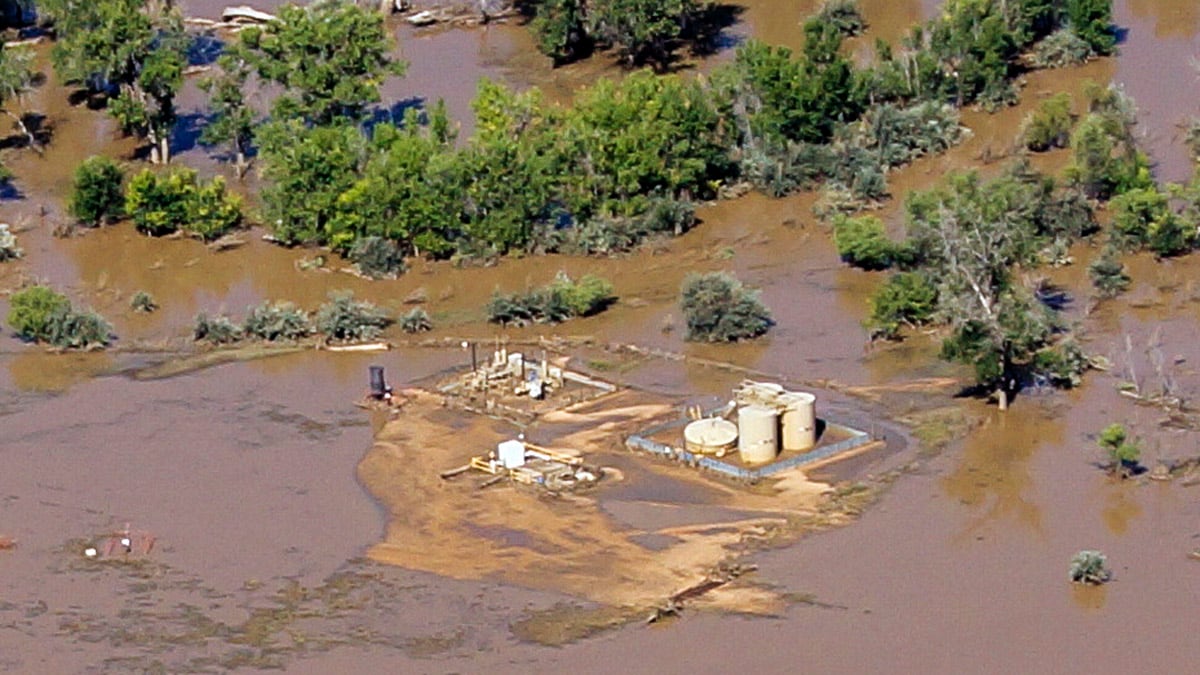As skies clear and rescue efforts wind down, Colorado is beginning to take stock of the damage wrought by its week of biblical floods. Highways are destroyed, bridges collapsed, and homes ripped from their foundations. And down in Weld County, state agencies, researchers, industry personnel, and environmental activists are trying to figure out what’s happened to the hundreds of oil and gas wells that lie underwater.

Weld County is the most heavily drilled area in the state, with over 20,000 active oil and gas wells, many of them in a low-lying basin where floodwaters running off the neighboring Rocky mountains converged. “There are well pads underwater and condensate tanks that have broken free and floated down the river,” says Cliff Willmeng, an anti-fracking activist who has been surveying the scene from the air. “In terms of damage, I’ve never seen anything like it.”
Willmeng and other environmental activists have been sounding the alarm, chiefly through photos shared on social media, that Colorado’s natural disaster is about to be compounded by an industrial one: chemicals from the state’s booming oil and gas industry, unleashed on the environment by the flood. His organization, East Boulder County United, has been posting pictures of inundated wells and broken tanks floating down swollen rivers.
The Colorado Oil and Gas Association (COGA), an industry trade group, says it’s too soon to know the extent of damage, but that oil and gas production at most wells was stopped—”shut in” is the industry term—as the flooding began. Tisha Schuller, COGA’s CEO, says that nearly 1,900 wells in the flooded area are currently shut-in.
But experts say it’s not the stuff inside the wells that would be a problem. The tight seals and sturdy valves designed to keep oil and gas from leaking out should also keep water from leaking in. Unless debris knocked off a wellhead, the oil and gas is safely locked inside. Of more immediate concern are the chemicals stored above ground at the well sites.
When you pump oil and gas, you get what’s called “produced water”—liquid that was lodged underground along with the hydrocarbons you’re trying to extract. Though naturally occurring, it’s not pleasant stuff. It can contain salts, metals, and sediments that are sometimes toxic or radioactive. It’s usually trucked to another location and reinjected into a saline aquifer—something that has no chance of being used for human consumption—but for a while it’s stored in tanks at the drill site.
If the well is still being drilled, you also have drill fluids stored nearby. For oil wells this can include lubricants and other chemical agents that help bore through earth and rock. For gas, it’s a cocktail of chemicals that gets mixed with water and sand and injected into the well at high pressure in order to fracture the shale—hence, “fracking”—and release natural gas.
Ron Cohen, an environmental engineer at the Colorado School of Mines laughs when I ask him what’s in the fracking cocktail. Drilling companies call their recipes trade secrets and guard them aggressively. Colorado has some of the strongest requirements of any state in terms of making companies tell regulators what chemicals they’re using, but even then they tell only the regulators and, in the event of a spill, emergency and medical personnel. Still, says Cohen, we have a pretty good idea of what’s in them, and it can be dangerous in high concentrations. There are things like benzene, a carcinogen, hydrochloric acid, glycol, and other chemicals you wouldn’t want in your drinking water.
The good news is that the current rock-bottom price of natural gas—because of all the recent fracking—means that there isn’t much new fracking going on right now. Most of the wells in Colorado are oil wells or already-fracked gas wells that are now being pumped. COGA said in a statement that “there were no known fracking operations being conducted in the flooded areas.” The Colorado Oil and Gas Conservation Commission confirmed that, saying that fracking fluids are only stored on site during the fracking phase, which is over for the “vast majority” of wells in the area. It’s not fracking chemicals COGCC is primarily concerned with. It’s crude oil. Last night, a damaged oil tank at an Anadarko well was found to have leaked about 5,000 gallons of oil into the South Platte River.
In a perverse silver lining, Cohen says the unprecedented size of the floods could end up ameliorating some of the environmental damage they cause, by diluting pollutants to the point where they aren’t as hazardous. Not that the floodwater isn’t hazardous already: Even if nothing spilled from the well sites, the floodwater is full chemicals from people’s garages, pesticides and manure from farms, and raw sewage from overwhelmed sewers and treatment plants. The Department of Public Health is warning people to stay out of the floodwater and to wash themselves immediately if they come in contact with it.
Stephen Osborn, a professor at Cal Poly Pomona who recently published a paper on drinking water contamination from fracking, agrees with Cohen that a tank of produced water would likely be diluted to non-harmful levels by the flood, but without knowing exactly what was spilled it’s too soon to say for sure. He happened to be studying groundwater in Weld County when the floods came and decided to change his research goals. Now he’s testing floodwaters for chemicals involved in oil and gas drilling.
COGA says 600 industry personnel are currently conducting air and ground surveillance of well sites, trying to assess the damage. Schuller said COGA is aware of the “social media frenzy” over pictures of inundated wells and floating tanks, and asked anyone with photos to send them to COGA along with information about their location. Schuller said two empty tanks were confirmed floating in flood water, some small broken lines had been remotely shut off, and some mixed oil and water had spilled, but no major oil and gas releases had been found.
Encana, the Canadian company that runs the most oil and gas wells in Colorado, said that its environmental team is in the process of inspecting its wells and has “found no significant spills or releases.” Of the 397 wells Encana shut down when flooding began, about 150 are back online.
The Colorado OIl and Gas Conservation Commission and the Colorado Department of Public Health have also dispatched teams of inspectors, but they’re having trouble reaching sites that are still flooded. In the meantime, like COGA, they’re surveying from the air and soliciting information from the public.
As the floodwaters recede, government inspectors, industry workers, academic researchers, and environmental activists will have to continue watching the situation, testing water and looking for leaks. Cohen, the environmental engineer, thinks it’s too soon for activists to use the floods as an example of fracking’s evils, lest it turn out, as he suspects, that the wells held up fairly well. On the other hand, he was surprised at the cautious response from COGA: saying only that no major spills had been found so far, but not ruling out the possibility that they occurred.
“I think oil and gas people didn’t expect this event—neither did anybody else,” says Cohen, the environmental engineer with the School of Mines. “There could be problems here and there, but I don’t think it’s going to be a disaster. I hope my prediction holds true.”






